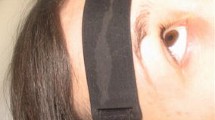Abstract
Ocular vestibular evoked myogenic potentials (oVEMP) are strongly influenced by recording conditions and stimulus parameters. Throughout the published literature, a large variety of stimuli is used for eliciting oVEMP. Our objective was to determine the effects of different rise/fall times and plateau times on oVEMP amplitudes and latencies. 32 healthy subjects were enrolled in the study. 500 Hz air-conducted tone bursts with the parameters rise–plateau–fall time 0–4–0, 4–0–4, 2–2–2 and 2–4–2 ms were used for eliciting oVEMP. For all stimuli, response prevalences were 100 %. The 4–0–4 ms stimulus generated the smallest amplitudes, whereas the 2–2–2 and 0–4–0 ms stimuli achieved the largest amplitudes. n1 and p1 latencies were significantly shorter for the 0–4–0 ms than for the other stimuli, whereas latencies in response to the 4–0–4 ms stimulus were prolonged. Hence, a variety of stimuli is suitable for evoking oVEMP in healthy subjects. We recommend a 2–2–2 ms stimulus for clinical testing of oVEMP elicited by air conducted sound, because it reproducibly generates oVEMP without exposing the ear to unnecessary amounts of acoustic energy.





Similar content being viewed by others
References
Kantner C, Gürkov R (2012) Characteristics and clinical applications of ocular vestibular evoked myogenic potentials. Hear Res 294:55–63
Rosengren SM, Welgampola MS, Colebatch JG (2010) Vestibular evoked myogenic potentials: past, present and future. Clin Neurophysiol 121:636–651
Govender S, Rosengren SM, Colebatch JG (2009) The effect of gaze direction on the ocular vestibular evoked myogenic potential produced by air-conducted sound. Clin Neurophysiol 120:1386–1391
Todd NP, Rosengren SM, Colebatch JG (2009) A utricular origin of frequency tuning to low-frequency vibration in the human vestibular system? Neurosci Lett 451:175–180
Murnane OD, Akin FW, Kelly KJ, Byrd S (2011) Effects of stimulus and recording parameters on the air conduction ocular vestibular evoked myogenic potential. J Am Acad Audiol 22:469–480
Lim LJ, Dennis DL, Govender S, Colebatch JG (2013) Differential effects of duration for ocular and cervical vestibular evoked myogenic potentials evoked by air- and bone-conducted stimuli. Exp Brain Res 224:437–445
Cheng YL, Wu HJ, Lee GS (2012) Effects of plateau time and ramp time on ocular vestibular evoked myogenic potentials. J Vestib Res 22:33–39
Cheng PW, Murofushi T (2001) The effect of rise/fall time on vestibular-evoked myogenic potential triggered by short tone bursts. Acta Otolaryngol 121:696–699
Cheng PW, Murofushi T (2001) The effects of plateau time on vestibular-evoked myogenic potentials triggered by tone bursts. Acta Otolaryngol 21:935–938
Krause E, Mayerhofer A, Gürkov R, Drexl M, Braun T, Olzowy B, Boetzel K (2013) Effects of acoustic stimuli used for vestibular evoked myogenic potential studies on the cochlear function. Otol Neurotol 34:1186–1192
Acknowledgments
The Eclipse VEMP recording system was provided by Interacoustics AS, Denmark, for the duration of the study.
Conflict of interest
The authors declare that they have no conflict of interest.
Author information
Authors and Affiliations
Corresponding author
Rights and permissions
About this article
Cite this article
Kantner, C., Hapfelmeier, A., Drexl, M. et al. The effects of rise/fall time and plateau time on ocular vestibular evoked myogenic potentials. Eur Arch Otorhinolaryngol 271, 2401–2407 (2014). https://doi.org/10.1007/s00405-013-2697-4
Received:
Accepted:
Published:
Issue Date:
DOI: https://doi.org/10.1007/s00405-013-2697-4




